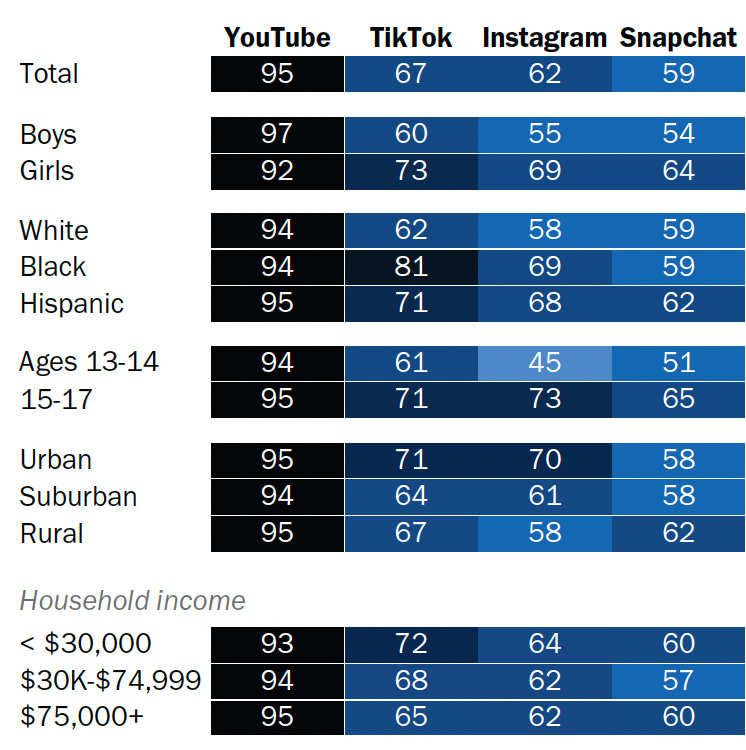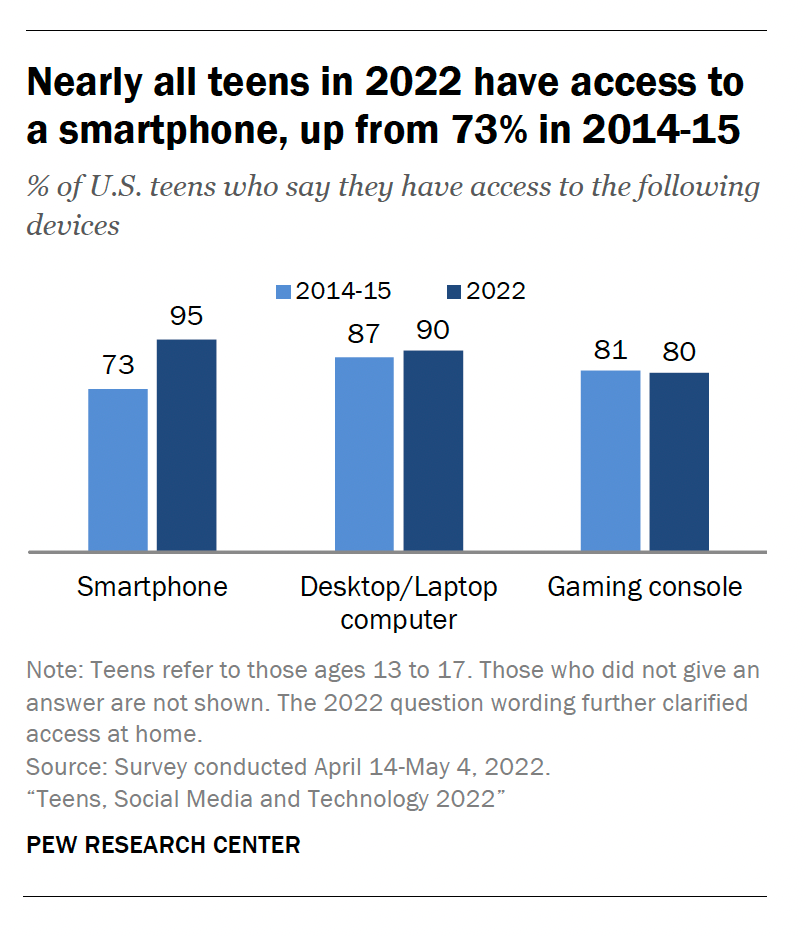Welcome to Techno Sapiens! Subscribe to join thousands of other readers and get research-backed tips for living and parenting in the digital age.
Summary for busy sapiens
New survey data on teens, smartphones, and social media was just released by Pew Research Center.
67% of teens are using TikTok. Only 32% are still using Facebook.
95% of teens have access to a smartphone, up from 73% in 2015
77% of teens use YouTube daily
35% of teens report that they are on social media “almost constantly.”
6 min read
Have you ever had that experience, where you’re convinced something is true, but you can’t find the evidence to support it?
No, you say to your friends, I swear. I know so many people who randomly have the same birthday, it’s definitely more common than you’d think. They shake their heads—Yea, I mean, the chances are probably 1 in 365, so it can’t be that common—and then go about their days. And then you go searching for evidence, and there’s a Reddit thread with people saying, “Yes! I had the same birthday as two people in my 2nd grade class!” and “My brother and my son have the same birthday—how weird is that?” but that’s not especially convincing data. Then one day, it happens. You pop open the New York Times and there’s an article. The so-called Birthday Paradox. And you think: I knew it! The chances that two people share a birthday in a group of just 23 people are 50-50!1 Way higher than we would think!
Anyway, that’s how I felt last week when this survey came out.
We suspected that TikTok had surpassed Instagram and Snapchat in its popularity among teens, but we didn’t have the data to support that. Now we do.
New data! Hooray!
In March, I wrote about newly-released survey data from Common Sense Media on media use in teens and tweens. That data was collected in Fall 2021, and provided some fascinating insights on kids’ screen time, changes during the pandemic, smartphone ownership, and platform use.
Now, we have more up-to-date data from the Pew Research Center2, collected in April and May 2022, and already summarized into neat little figures. This turnaround time—data collected in May, report out by August—is the research equivalent of ordering UberEats3 and having it arrive at your doorstep in less than 15 minutes. How did they do that so fast?
Luckily, I spend my time lying in wait for moments like this, so I. Am. Ready.
Let’s dive in!
Tell me about the data
Our friends at the Pew Research Center conducted this survey between April and May 2022. They do these types of surveys somewhat regularly, so, for comparison, they also have data from 2014-15.
A nationally representative sample of 1,316 U.S. teens self-reported answers to the survey questions online.
The report gives us data on the sample as a whole, and also by subgroups. These subgroups include:
Boys and girls
White, Black, and Hispanic teens
Younger (ages 13-14) and older (15-17) teens
Teens in lower income (<$30,000 per year), medium income ($30k-$74,999), and higher income ($75,000+) homes
For those of us who are into this sort of thing, the report also provides some great figures (charts, graphs, etc.). I mean, the color palette, the labeling, the overall data representation—really top notch. I’ll share some of these below.
So, Facebook’s out and TikTok’s in?
You got it.
Take it directly from the report’s subheading: TikTok has established itself as one of the top online platforms for U.S. teens, while the share of teens who use Facebook has fallen sharply.
Burn!
Let’s take a look at the numbers.
67% of teens are using TikTok. Instagram (62%) and Snapchat (59%) are right behind.
Facebook (32%) and Twitter (23%) continue to be the domain of the old and out-of-touch (me, for example)
YouTube is in a league of its own, with 95% of teens saying they use it.
The rest of the platforms, though we hear a lot about them, remain somewhat uncommon among teens—only 20% of teens are on Twitch, for example, and 14% on Reddit.
This has all changed drastically since 2014-15, at which time TikTok didn’t yet exist, and Facebook was dominant.
A few interesting differences emerge in which teens use each platform, as we see in the below chart.
Let’s take TikTok as an example. Nearly three-quarters of girls use it, while only 60% of boys do. 81% of Black teens, 71% of Hispanic teens, and 62% of White teens use it. And 71% of older teens use it, compared to only 61% of younger teens.
What devices are teens using?
95% of all teens have access to a smartphone. This is remarkably consistent across gender, income, and racial/ethnic subgroups. This number has increased significantly since 2014-15, when only 73% of teens reported having access.
When it comes to computers and gaming consoles (unlike smartphones), there are differences in access by income subgroup.
90% of all teens have access to a computer—but this varies from 79% for lower income teens to 94% for higher income teens.
80% of all teens have access to a gaming console—70% of lower income teens and 82% of higher income teens.
How much are teens using these platforms?
A quick methods note: to ask about frequency of use, the survey used single-item multiple choice survey questions. The answer choices were: Almost constantly, Several times a day, About once a day, Several times a week, or Less often.
Perhaps not surprisingly, 94% of teens say they use the Internet at least several times per day. 46% say they use it “almost constantly.” This number has nearly doubled since 2014-15, when only 24% said they use the Internet “almost constantly.”
Now, how about specific platforms? Here’s another excellent figure, which shows us that 60% of teens are on YouTube “several times a day” or more. Nearly half of teens are on TikTok several times a day or more.
Not pictured in the figure: 35% of all teens report that they are on at least one of these five platforms “almost constantly.”
How do teens feel about their social media use?
It will come as no surprise to techno sapiens that my favorite part of the survey involved asking teens how they feel about their social media use. Do they think they’re spending too much time on it? Do they think it would be hard for them to give it up?
More than one-third (36%) of teens say the amount of time they spend on social media is “too much.” 55% say the amount of time they spend is “just right,” and 8% “too little.”
Girls (41%) are more likely than boys (31%) to say they spend too much time, as are older teens (42%) versus younger teens (28%)
How hard do teens think it would be for them to give up social media completely? 18% of teens say it would be “very hard” and 35% say “somewhat hard.” These numbers are, again, higher for girls and older teens.
Key takeaways
These data remind us of two important truths in the world of smartphones and social media.
First, teens are not all the same. We like to describe Gen Z as a monolith—they have short attention spans! They can’t handle face-to-face interactions! They’ve never heard of the Beatles! But these data remind us that teens differ in their tech habits. Half of teens say it would be hard to give up social media, but the other half say it would be easy. 67% of teens use TikTok, but that leaves nearly one-third who do not. It’s important for us to pay attention to these differences, whether we’re researchers studying social media’s impact on teens, or parents trying to navigate tech for our own children.
Second, when it comes to smartphones and social media, things change fast. It’s been only seven years4 since the last Pew survey and, in that time, a platform that didn’t even exist in 2015 has come to dominate the landscape. Smartphone ownership has become nearly universal. And a platform that once topped the charts has fallen in dramatic fashion. Imagine what teens’ tech lives will look like seven years from now—I’d venture a guess that new platforms, new trends, and new devices will have arisen.
A quick survey
What did you think of this week’s Techno Sapiens? Your feedback helps me make this better. Thanks!
The Best | Great | Good | Meh | The Worst
In case you missed it
But actually—can you believe this Birthday Paradox fact? The chances that two people share a birthday in a group of 23 people are 50-50. In a group of just 75 people, the chances that two people share a birthday are 99.9%! Here’s the Wikipedia page for those who want to really get into the math, but the basic idea is that when you have, say, 23 people in a room, there are actually a lot of possible pairs of people (253 possible pairs, to be exact). When we first try to figure out the probability of a birthday match, we mistakenly think about our own birthday. The chances that someone in a room of 23 people was also born on December 6 are very small (though, incidentally, there did happen to be two others in my third grade class with my same birthday). But the chances that someone shares a birthday with someone else in that group are much larger. And here we all were thinking statistics were boring!
All figures in this post were taken directly from the report. Citation: Vogels, E.A., Gelles-Watnick, R., & Massarat, N. Teens, Social Media and Technology 2022. Pew Research Center. You can access the full report here.
I not only sometimes order dinner from UberEats (or other delivery services), but have also recently discovered the possibility of ordering frozen yogurt. Each time I order, the guilt and horror at seeing the subtotal (with “service” and “delivery” fees added) is only slightly outweighed by the delight of convenient and tasty chocolate soft serve with crushed Oreo topping. Is it worth it? No. Will I stop doing it? Also, no.
To remind myself of what was happening in my life seven years ago, I took a quick trip down memory lane (i.e., the “Photos” app on my computer). The only photo from the week of August 22, 2015 was this one—a photo of Figure 2.8 in the Abnormal Psychology textbook I was using to teach this class to a group of 35 undergrads at UNC (two of which, probably, shared the same birthday). The figure is labelled “The Endocrine System” and contains a photo of a woman and man, creepily labeled with body parts that make up the endocrine system. You’ll note that the man has a number of labels—hypothalamus, pituitary gland, thyroid, pancreas, etc. The woman, inexplicably, has only “ovary.” If that’s not a metaphor for something, I don’t know what is.









